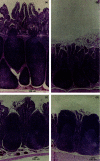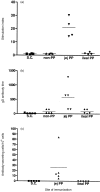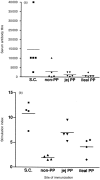Ileal and jejunal Peyer's patches play distinct roles in mucosal immunity of sheep
- PMID: 10447767
- PMCID: PMC2326853
- DOI: 10.1046/j.1365-2567.1999.00791.x
Ileal and jejunal Peyer's patches play distinct roles in mucosal immunity of sheep
Abstract
The majority of pathogens enter the body through mucosal surfaces and it is now evident that mucosal immunity can provide effective disease protection. However, the induction of mucosal immunity will require efficient targeting of mucosal vaccines to appropriate mucosa-associated lymphoid tissue. An animal model, based upon the surgical preparation of sterile intestinal 'loops' (blind-ended segments of intestine), was developed to evaluate mucosal and systemic immune responses to enteric vaccines in ruminants. The effectiveness of end-to-end intestinal anastomoses was evaluated and fetal surgery did not disrupt normal intestinal function in lambs up to 6-7 months after birth. The immunological competence of Peyer's patches (PP) within the intestinal 'loops' was evaluated with a human adenovirus 5 vector expressing the gD gene of bovine herpesvirus-1. This vaccine vector induced both mucosal and systemic immune responses when injected into intestinal 'loops' of 5-6-week-old lambs. Antibodies to the gD protein were detected in the lumen of intestinal 'loops' and serum and PP lymphocytes proliferated in response to gD protein. The immune competence of ileal and jejunal PP was compared and these analyses confirmed that jejunal PP are an efficient site for the induction of mucosal immune responses. This was confirmed by the presence of gD-specific antibody-secreting cells in jejunal but not ileal PP. Systemic but not mucosal immune responses were detected when the vaccine vector was delivered to the ileal PP. In conclusion, this model provided an effective means to evaluate the immunogenicity of potential oral vaccines and to assess the immunological competence of ileal and jejunal Peyer's patches.
Figures



Similar articles
-
Marked Differences in Mucosal Immune Responses Induced in Ileal versus Jejunal Peyer's Patches to Mycobacterium avium subsp. paratuberculosis Secreted Proteins following Targeted Enteric Infection in Young Calves.PLoS One. 2016 Jul 7;11(7):e0158747. doi: 10.1371/journal.pone.0158747. eCollection 2016. PLoS One. 2016. PMID: 27387969 Free PMC article.
-
Multiple intestinal 'loops' provide an in vivo model to analyse multiple mucosal immune responses.J Immunol Methods. 2001 Oct 1;256(1-2):19-33. doi: 10.1016/s0022-1759(01)00429-x. J Immunol Methods. 2001. PMID: 11516752
-
Differential cytokine mRNA expression in single lymphatic follicles of the calf ileal and jejunal Peyer's patches.Dev Comp Immunol. 2009 Apr;33(4):430-3. doi: 10.1016/j.dci.2008.09.007. Epub 2008 Oct 9. Dev Comp Immunol. 2009. PMID: 18845180
-
The sheep and cattle Peyer's patch as a site of B-cell development.Vet Res. 2006 May-Jun;37(3):401-15. doi: 10.1051/vetres:2006008. Epub 2006 Apr 14. Vet Res. 2006. PMID: 16611555 Review.
-
The intestinal habitat for organized lymphoid tissues in ruminants; comparative aspects of structure, function and development.Vet Immunol Immunopathol. 1991 Mar;28(1):1-16. doi: 10.1016/0165-2427(91)90038-e. Vet Immunol Immunopathol. 1991. PMID: 1905075 Review.
Cited by
-
Marked Differences in Mucosal Immune Responses Induced in Ileal versus Jejunal Peyer's Patches to Mycobacterium avium subsp. paratuberculosis Secreted Proteins following Targeted Enteric Infection in Young Calves.PLoS One. 2016 Jul 7;11(7):e0158747. doi: 10.1371/journal.pone.0158747. eCollection 2016. PLoS One. 2016. PMID: 27387969 Free PMC article.
-
Surface-displayed porcine epidemic diarrhea viral (PEDV) antigens on lactic acid bacteria.Vaccine. 2007 Dec 21;26(1):24-31. doi: 10.1016/j.vaccine.2007.10.065. Epub 2007 Nov 20. Vaccine. 2007. PMID: 18054413 Free PMC article.
-
Induction of intestinal lymphoid tissue formation by intrinsic and extrinsic signals.Semin Immunopathol. 2009 Jul;31(2):151-69. doi: 10.1007/s00281-009-0163-6. Epub 2009 Jun 9. Semin Immunopathol. 2009. PMID: 19506873 Review.
-
Modulation by colostrum-acquired maternal antibodies of systemic and mucosal antibody responses to rotavirus in calves experimentally challenged with bovine rotavirus.Vet Immunol Immunopathol. 2004 Jul;100(1-2):7-24. doi: 10.1016/j.vetimm.2004.02.007. Vet Immunol Immunopathol. 2004. PMID: 15182992 Free PMC article.
-
Age-related changes in the anatomical characteristics of Peyer's patches in small intestine of Bactrian camels (Camelus bactrianus).Trop Anim Health Prod. 2011 Aug;43(6):1219-23. doi: 10.1007/s11250-011-9829-x. Epub 2011 Apr 3. Trop Anim Health Prod. 2011. PMID: 21461871
References
-
- Czerkinsky C, Holmgren J. The mucosal immune system and prospects for anti-infectious and anti-inflammatory vaccines. The Immunologist. 1995;3:97.
-
- Coffin SE, Klinek M, Offit PA. Induction of virus-specific antibody production by lamina propria lymphocytes following intramuscular inoculation using rotavirus. J Infect Diseases. 1995;172:874. - PubMed
-
- Matson DO, O’ryan ML, Herrera I, Pickering LK, Estes MK. Fecal antibody responses to symptomatic and asymptomatic rotavirus infections. J Infect Diseases. 1993;167:577. - PubMed
-
- Cebra JJ, Shroff KE. Peyer’s patches as inductive sites for IgA commitment. In: Ogra P L, Mestecky J, Lamm M E, Strober W, McGhee JR, Bienenstock J, editors. Handbook of Mucosal Immunology. London: Academic Press; 1994. p. 151.
-
- Griebel PJ, Hein WR. Expanding the role of Peyer’s patches in B-cell ontogeny. Immunology Today. 1996;17:30. - PubMed
Publication types
MeSH terms
Substances
LinkOut - more resources
Full Text Sources
Other Literature Sources
Miscellaneous

